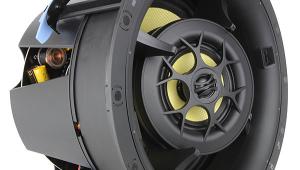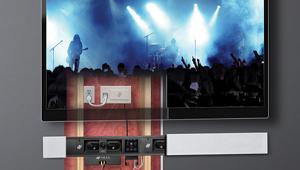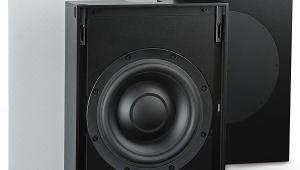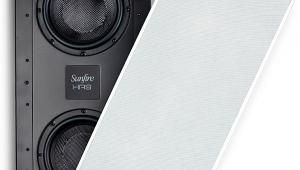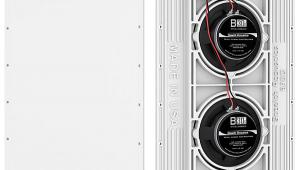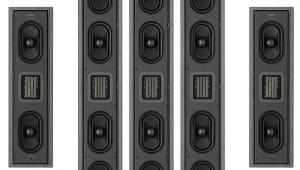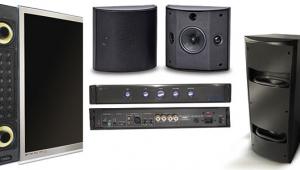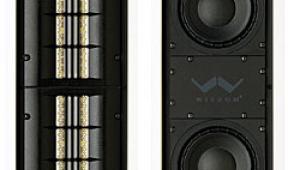PSB Imagine W3 On-Wall Soundbar System Page 2
Let me give you a musical example. In the eclectic Hot Club of Detroit’s “Hey” (Junction), the music starts slow, builds, slows, and builds throughout. At the beginning, the presence of Julien Labro’s accordion is palpable, making it seem as though it were actually the very air in my theater room that was pumping in and out of the carefully controlled bellows. It’s not long before saxophonists Jon Irabagon and Andrew Bishop engage in a spirited, intertwining duet—more of a duel, really—in which, once again, the horns hang in the air, suspended by nothing but the incredible delicacy of the Imagine W3’s dome tweeters.
On Marcus Miller’s solo release, Marcus, the song “Higher Ground” challenges the PSB SubSeries 200 with a succession of low bass guitar notes. In addition to the subwoofer providing exceptionally deep and taut bass response, the SubSeries 200 was stunning in its ability to blend with the Imagine W3. Initially, I was a tad concerned by PSB’s published specs indicating the W3 only went down to 90 Hz. Based on the numbers, I was pretty sure there’d be some slight smearing in low vocals or guitar string plucks. Instead, I found the W3 and SubSeries 200 to be an ideal matchup, providing one of the most engaging and seamless soundbar/subwoofer combinations I’ve heard for the money. With two-channel music, compared with other soundbar systems, there were times when the soundstage seemed slightly constrained—not surprising when your speakers are less than 40 inches apart. Other systems sometimes use spatial processing or other acoustic tricks to widen the soundstage, but this isn’t always perfect and can have minor disorienting effects depending on the source material. Based on the results, I can’t argue with PSB’s choice of going the straightforward, “damn the DSPs” route.
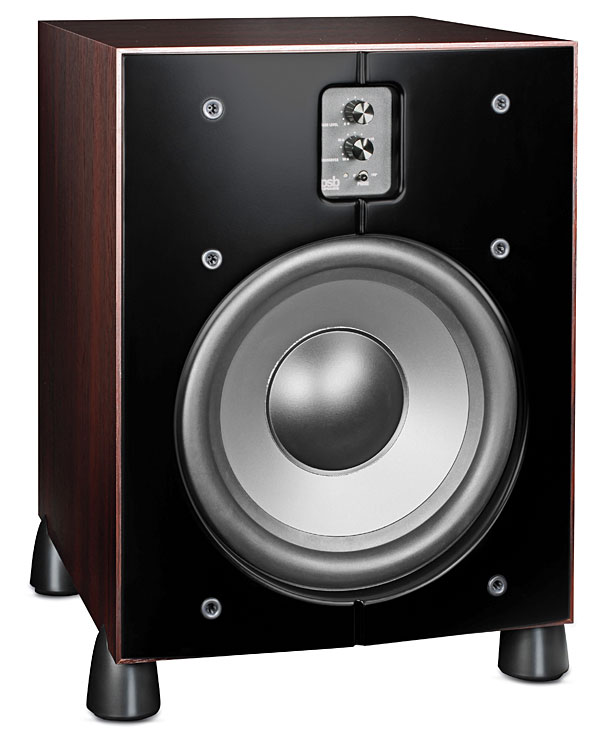
This Package Delivers
When it came to movies, one of the system’s most amazing aspects was the fact that the W1 on-wall speaker—even mounted vertically, as in my case—sounded unbelievably identical to the horizontal W3. In many systems, the timbre, or character, of the surround speakers can be marginally (or substantially) different than that of the LCR. As a result, there are often subtle changes in the nature of a sound as it moves from the back of the room to the front, and vice versa. That ever-so-slight break in the sonic continuity of the movie experience is a small thing that doesn’t really draw attention to itself unless you’re specifically looking for it. On the other hand, with a system such as this, the flawless blend between the soundfields created by the front and surround speakers is immediately noticeable—as if an acoustic weight were lifted from your ears.
In Premium Rush, for example, the soundtrack (sometimes jarringly) keeps track with the frantic pace of the onscreen action, as well as the varying perspectives. The movie is very spacious, and the Imagine W3 system reproduced that amazingly well. Throughout the movie, the W1s integrated so well with the W3, as when, early on, Detective Monday (Michael Shannon) is thrashing a suspect and the loud noise from a truck or bus moving across the back of the room is perfectly integrated with—and covers up—most of the noise of the beating. When Wilee (Joseph Gordon-Levitt) uses his GPS to get directions to his next stop, the sounds of the city locations jump around the room. And it’s a true premium rush near the end of the movie as Wilee and Manny (Wolé Parks) race through the streets with the street signs whipping past along the sides of the room.
Switching gears from the adrenaline-laden bicycle fest of Premium Rush to the intense intellectual stimulation of Resident Evil: Retribution, during the opening scene’s barge attack sequence, there was an amazing integration of the W3 and the surround pair of W1s. PSB’s Imagine W3/W1 combo was absolutely incredible at building a coherent and stable three-dimensional soundfield that extended well into the back of the room. After the initial backstory zombie attacks, when Alice (Milla Jovovich) and Ada (Bingbing Li) are trying to escape from deep within the Umbrella Corporation’s headquarters, they must fight their way through several simulated cities. In the Tokyo sequence, the sound of rain falling is present throughout the room before the obligatory blood fest begins. The beauty of how well the speakers work together was brought out when Alice, fighting off zombie after zombie, swings a heavy chain with a lock at the end of it through the air—and the fluid way the W3 and W1s reproduced the sound of the motion through the room made me involuntarily duck out of the way. Bringing out another pleasant aspect of the movie, the system was almost a bit too real whenever a zombie got shot in the head, and thanks to the magic of Hollywood, the blood and gore clearly splashed from the front to the rear.
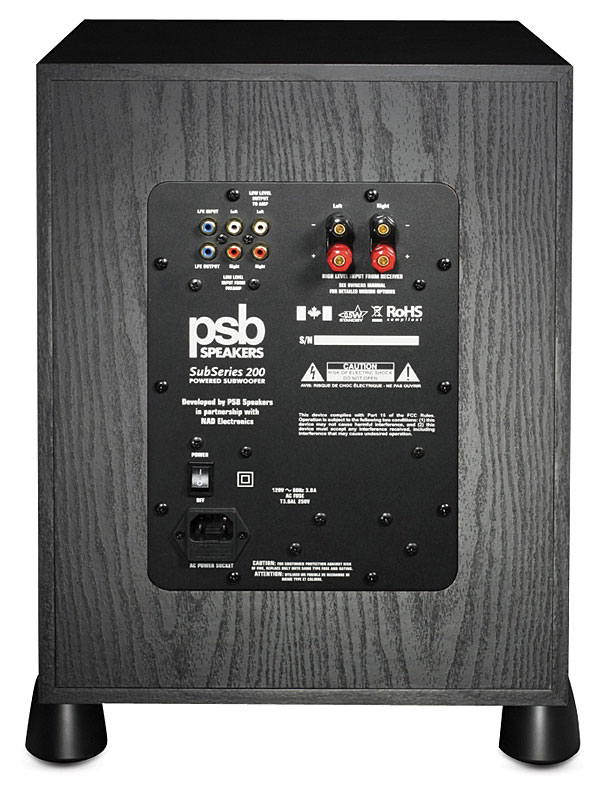
As you might guess, the SubSeries 200 got plenty of chances to show off in the movie, too. During the penultimate gun battle at the bottom of the soon-to-blow elevator shaft, the bass is hard-hitting and very well controlled. But the real test came after Alice and the rescue party reach the frozen surface of the sea above the underground complex and a submarine from below attempts to crack the ice and break through (offering yet another chance for a gunfight!). While not as shake-your-booty—and everything else on your body—deep and strong as a larger, more expensive (or smaller and even more expensive) subwoofer, I was nicely surprised by the way the SubSeries 200 handled the extremely powerful and deep sound of the ice breaking underneath everyone’s feet. Without a doubt, the SubSeries 200 is a standout in the under-$700 subwoofer category.
Conclusion
OK, so forgive me if I came across a bit heavy-handed in the beginning of this review. In my defense, it’s absolutely true that the PSB Imagine W3/W1/SubSeries 200 setup doesn’t have a slew of new-acoustic-age, impressive-sounding-in-a-press-release technobabble excitement to attract the all-too-capricious attention of the masses (and provide fodder for reviews). But you shouldn’t interpret that to mean that this PSB system itself isn’t exciting. In fact, after setting down the paperwork and setting up the speakers, the W3 and W1s with the SubSeries 200 create such a wonderfully coherent and integrated sonic environment that it makes you wonder if maybe
you didn’t peruse the wrong brochures. There’s an intangible, impossible-to-measure seamless whole created when the system’s individual pieces are brought together—and it’s what makes the W3/W1/SubSeries 200 theater speaker package such a standout. My hat is off to Paul Barton and PSB for proving once again that good, solid engineering and design (influenced, certainly, by 40 years of research experience) executed with a real focus on what matters most—the quality of the sound—can still produce excellence.




